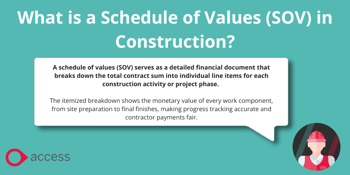A Contractor's Guide to Schedule of Values in Construction: Definition, Examples, Best Practices
Construction schedules of values (SOVs) provide a detailed breakdown of project costs that contractors must prepare before work begins. A schedule of values in construction determines how contractors get paid. With 70% of contractors reporting that inadequate project coordination leads to budget overruns, creating accurate cost breakdowns has become increasingly critical.
Poorly prepared SOVs can lead to serious consequences, including delayed payments, cash flow problems, and project disputes.
Specialized construction software has made managing schedules of values documentation easier, helping contractors create accurate breakdowns and maintain compliance.
In this guide, you'll find step-by-step processes, detailed examples, and best practices for implementation.
Contents
- What is a Schedule of Values in Construction?
- Schedule of Values in Construction - Key Takeaways
- Why is a Schedule of Values Important in Construction?
- What Information is Included in a Schedule of Values?
- Schedule of Values Template/Example
- What is the Schedule of Values Process?
- Schedule of Values Best Practices
What is a Schedule of Values in Construction?
A schedule of values (SOV) serves as a detailed financial document that breaks down the total contract sum into individual line items for each construction activity or project phase.
The itemized breakdown shows the monetary value of every work component, from site preparation to final finishes, making progress tracking accurate and contractor payments fair.
General contractors create the SOV right after receiving project award and before submitting their first payment application. They build these documents using Microsoft Excel spreadsheets or specialized construction management software. Once the owner or architect approves the SOV, it becomes an official contract document, guiding all future payment applications throughout the project.

Schedule of Values in Construction - Key Takeaways
The following key points summarize the essential aspects of what is a schedule of values in construction:
-
A schedule of values breaks down the total contract sum into specific line items that represent each construction activity or project phase
-
Contractors prepare SOVs between project award and first payment application, using spreadsheets or construction software to track costs
-
Owners and architects must approve the SOV before it becomes an official payment tracking document for the project
-
Regular updates and proper formatting help contractors maintain accurate records and receive timely payments throughout construction
Access Coins ERP – Developed by and for construction experts
Access Coins is an all-in-one ERP that covers everything from cost forecasting to workforce management.
Why is a Schedule of Values Important in Construction?
Schedule of values (SOV) documentation serves multiple critical functions in construction projects. They organize work scopes and costs in a way that makes sense to all project stakeholders.
A 2019 cash flow survey revealed that 98% of construction companies have used mechanical liens to secure payment, highlighting the SOV's vital role in payment management. SOVs keep project finances and progress on-track.
Well-structured SOVs prevent disputes between contractors and owners by assigning accurate values to each work item. Prompt contractor payments based on completed work prevent cash flow disruptions that can derail projects. SOVs also provide a clear financial baseline and straightforward method for tracking change orders as project scopes shift.
What Information is Included in a Schedule of Values?
A schedule of values (SOV) should include various types of information to ensure clarity, transparency, and effective project management. The following list outlines the essential components of a well-prepared SOV:
- Project information
Project name, location, owner, architect, and contractor details
- Item numbers
Unique identifiers for each line item
- Description of work
Specific materials, equipment, and labor for each task
- Quantity
Required amounts of materials and labor per line item
- Unit of measure
Square feet, linear feet, or cubic yards for each item
- Unit price
Cost per unit of measure
- Item value
Total value calculated by quantity times unit price
- Scheduled value
Contract sum allocated to each line item
- Percentage of total contract
Each line item's value as a percentage of total sum
- Change orders
Approved modifications to line items and project costs
- Payment applications
Updates on completed work and stored materials
Schedule of Values Template/Example
Let's look at a simple example to understand better the structure and content of a schedule of values (SOV). The following table represents a typical SOV for a small construction project:
|
Item No. |
Description of Work |
Quantity |
Unit |
Unit Price |
Item Value |
Scheduled Value |
% of Total |
|
1 |
Mobilization |
1 |
LS |
$5,000 |
$5,000 |
$5,000 |
2.5% |
|
2 |
Site Clearing |
1 |
AC |
$3,000 |
$3,000 |
$3,000 |
1.5% |
|
3 |
Excavation |
500 |
CY |
$20 |
$10,000 |
$10,000 |
5.0% |
|
4 |
Concrete Foundation |
200 |
LF |
$150 |
$30,000 |
$30,000 |
15.0% |
|
5 |
Structural Steel |
10 |
TON |
$4,000 |
$40,000 |
$40,000 |
20.0% |
|
6 |
Roofing |
5,000 |
SF |
$10 |
$50,000 |
$50,000 |
25.0% |
|
7 |
Electrical |
1 |
LS |
$25,000 |
$25,000 |
$25,000 |
12.5% |
|
8 |
Plumbing |
1 |
LS |
$20,000 |
$20,000 |
$20,000 |
10.0% |
|
9 |
Finishes |
1 |
LS |
$15,000 |
$15,000 |
$15,000 |
7.5% |
|
10 |
Demobilization |
1 |
LS |
$2,000 |
$2,000 |
$2,000 |
1.0% |
|
Total |
|
|
|
|
$200,000 |
$200,000 |
100% |
What is the Schedule of Values Process?
The schedule of values (SOV) process involves several steps to ensure the document's accurate and timely submission, review, and approval. Contractors must diligently follow these steps for smooth progress payments.
Preparation
Contractors begin by carefully examining the project scope, plans, and specifications to identify all the work items that need to be included in the SOV. They break down the total contract sum into smaller, manageable line items, ensuring that each item represents a significant portion of the work and aligns with the project schedule.
Submission
Once the SOV is complete, contractors submit it to the owner or architect for review, typically within a specified timeframe after receiving the notice to proceed. The submission usually includes a cover letter, the SOV document, and any supporting documentation, like material or equipment quotes.
Review and Approval
The owner or architect reviews the submitted SOV to ensure it’s accurate, complete, and compliant with the contract requirements. If needed, they may request additional information or clarification from the contractor. If the SOV is found satisfactory, the owner or architect approves it, making it an official part of the contract documents.
Progress Payments
As the project progresses, contractors update the SOV to reflect the work completed and materials stored to date. They submit the updated SOV along with each progress payment application, typically every month. The owner or architect reviews the payment application and verifies the claimed progress against the approved SOV before releasing funds.
Revisions and Change Orders
Contractors must revise the SOV accordingly if the project scope or contract sum changes during the work. They submit the revised SOV and request the change order for the owner's or architect's approval. Once approved, the revised SOV becomes the new baseline for future progress payments.
Closeout
Contractors must submit a final SOV and payment application when the project is nearly finished. The SOV should list all work done, including approved change orders and project costs. After the owner or architect approves the final SOV, contractors release the retention and close the deal.
Schedule of Values Best Practices
Creating and managing a schedule of values (SOV) requires planning, specificity, and stakeholder communication. Contractors may struggle with line itemization, cost estimation, and SOV-project schedule alignment. Consider these solutions to overcome these challenges and ensure a smooth SOV process:
Use a Clear and Consistent Format
Establish a standardized SOV format that is easy to read and understand. Use clear headings, line item descriptions, and units of measure. Maintain consistency in the level of detail provided for each line item to avoid confusion and ensure fair comparisons.
Break Down the Work into Manageable Line Items
Divide the project scope into line items representing significant and distinct work portions. Each line item should be manageable in cost and duration, allowing for accurate progress tracking and reporting. Avoid lumping together unrelated or dissimilar work items.
Align the SOV with the Project Schedule
To align the SOV with the project schedule, ensure the line items in the SOV match the activities outlined in the project schedule. Doing so will help you monitor progress, identify potential delays, and make well-informed decisions about allocating resources and adjusting the work plan as needed.
Provide Sufficient Detail
Include enough detail in the SOV to enable effective cost control and progress monitoring. Break down complex or high-value line items into sub-items to provide greater transparency and accuracy. However, avoid excessive granularity that may create unnecessary administrative burdens.
Use Accurate and Realistic Cost Estimates
The SOV should be based on each line item's accurate and realistic cost estimates. Historical data, vendor quotes, and industry benchmarks should be used to ensure the estimates' reliability. As appropriate, allowances for contingencies and escalations should be included, and the assumptions made in the estimating process should be documented.
Collaborate with Subcontractors and Suppliers
Engage subcontractors and suppliers in the SOV preparation to ensure accuracy and buy-in. Request their detailed cost breakdowns and incorporate them into the overall SOV. Define each subcontractor's scope of work and responsibilities to avoid gaps or overlaps.
Review and Update the Schedule of Values Regularly
Treat the SOV as a living document that requires regular review and updates. Monitor the actual costs incurred against the budgeted amounts for each line item and make necessary adjustments. Update the SOV to reflect approved change orders and any other scope modifications.
Ensure Consistency with Contract Documents
Verify that the SOV is consistent with the contract documents, including the plans, specifications, and general conditions. Clarify and resolve any discrepancies or ambiguities before submitting the SOV for approval.
Use Technology to Streamline the Process
Use construction management software and digital tools to automate and streamline the SOV process. Use templates, cost databases, and integration with project scheduling and accounting systems to improve efficiency, accuracy, and collaboration among project stakeholders.
Communicate Effectively
Maintain open and transparent communication with the owner, architect, and other project stakeholders throughout the SOV process. Promptly address any questions, concerns, or requests for additional information. Provide clear explanations and justifications for the SOV line items and any proposed revisions.
Streamline Your Schedule of Values Management with Access Coins
Manual SOV tracking burdens many construction teams with spreadsheet maintenance, version control issues, and payment tracking challenges.
Construction management software eliminates these headaches through automated SOV creation, real-time updates, and seamless payment application integration.
Watch our 4-minute demo to see how Access Construction helps teams manage schedules of values with greater accuracy and efficiency.

 UK
UK
 AU & NZ
AU & NZ
 SG
SG
 MY
MY
 IE
IE




